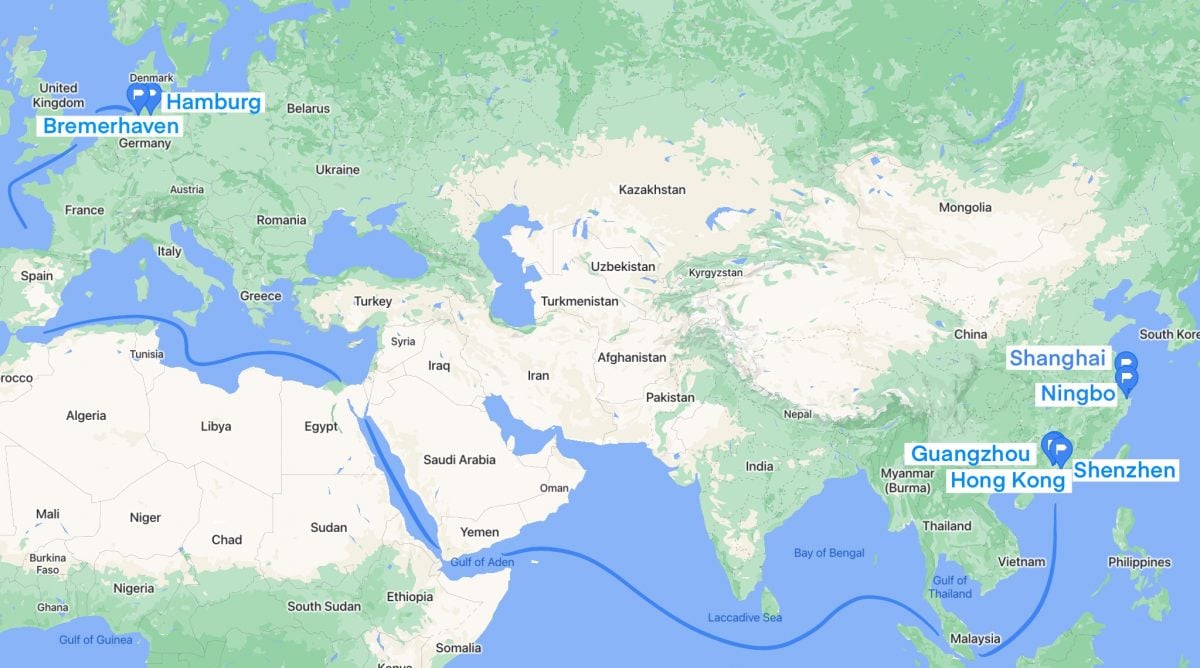Germany is China’s key trading partner. As Germany is in the center of Europe and the European Union, it is China’s key trading partner. For the last several years, China and Germany have maintained a strong trade relationship. In 2022, China was Germany’s most important trading partner, with total bilateral trade valued at about 260 billion USD. Both countries emphasize the necessity of promoting open markets and rules-based world trade. In this post, we will present the most popular shipping methods from China to Germany.
Shipping from China to Germany – types of transportation
Both Germany and China have a robust network of railways, highways, seaports, and airports that make shipping goods from across continents an efficient process. Choosing a shipping option depends on several factors, as every option has its advantages and disadvantages. These three shipping options are:
- ocean freight
- air freight (including express courier services, FedEx, DHL, etc.)
- rail freight.
Ocean freight from China to Germany
Ocean freight is the most popular freight option chosen by German importers when purchasing goods from China. This is due to the low shipping costs. Moreover, it enables the shipping of large shipments, reducing transport costs per unit.
When ordering a shipment of 12 pallets or more, FCL (Full Container Load) will be more advantageous. On the other hand, LCL (Less Than Container Load) is usually chosen by importers with smaller shipments (usually between 1-15 cubic meters in a container). As there is a need to manipulate the cargo along the way (consolidation and deconsolidation), LCL shipping takes slightly longer than standard FCL shipping.
How long does it take to ship from China to Germany?
Unfortunately, a significant disadvantage of ocean freight is the transit time. Containerships sailing from China to Germany usually start their journey in the South China Sea before sailing through the Indian Ocean to the Atlantic Ocean. This journey may take up to 45 days. The transit time depends on the port of arrival and the chosen form of transport (FCL or LCL).

Major seaports in China and Germany
Below we listed the main cargo seaports in China.
- Shanghai is the largest container seaport in the world and is part of the 21st-century Maritime Silk Road. The deep-water Port of Yangshan is the most important part of Shanghai’s airport, handling the largest amount of cargo.
- Shenzhen is the largest seaport in the Pearl River Delta and the fourth-largest container port in the world. It is also one of the fastest-growing seaports in the world, and it currently handles over 130 international container routes.
- Ningbo-Zhoushan, located on the coast of the East China Sea, is well connected to other cities in China. It is currently the world’s busiest cargo seaport in terms of cargo tonnage.
- Guangzhou is a deep-water cargo port located on the west side of the Pearl River Delta. It is a collective of ports, with Port Nansha accounting for almost a third of Port Guangzhou’s total throughout.
- Hong Kong is China’s fifth-largest seaport. As it is in the special administrative region of Hong Kong, it functions under its own set of laws, separate from Chinese laws.
Two main seaports in Germany handle most of the cargo from China.
- Hamburg is Germany’s largest seaport and Europe’s third-busiest container seaport. It is located on the river Elbe in northern Germany, 110 kilometers from the North Sea. In Germany, it is often called ‘Tor zur Welt,’ meaning the ‘Gateway to the World’.
- Bremen/Bremerhaven is commonly called the Bremische Häfen (‘Ports of Bremen’). It is several ports located alongside the Wesser river. It is Europe’s fourth-busiest container seaport and Germany’s second-largest seaport.
Air freight from China to Germany
Airfreight is the fastest form of shipping freight available. It is the best option when shipping perishable shipments or smaller orders (smaller than three pallets). For example, shipments from China can arrive in Germany in around 5-8 days by air. Additionally, air freight is safer than ocean freight. Therefore, it comes at a high price.
Express shipping is an all-included service that combines logistics and transport, making it even faster than standard air freight. Door-to-door shipping via express shipping will take as little as 1-4 days. However, because of the higher costs, it is mainly recommended for small shipments, like samples.

Major cargo airports in China and Germany
The are several big cargo airports in China.
- Hong Kong International Airport is the second-largest cargo airport in the world and the largest one in China. It accounts for half of Hong Kong’s external trade and connects to over 100 destinations worldwide, including Berlin, Frankfurt, and Munich.
- Shanghai Pudong International Airport is the third-largest airport hub in the world and the second-largest one in China. It is an Asian-Pacific cargo hub for FedEx, UPS, and DHL, with DHL being the largest in Asia.
- Beijing Capital International is China’s third-largest cargo airport and Munich Airport’s sister airport. Air China Cargo and Lufthansa Cargo operate direct flights from Beijing to Frankfurt.
- Guangzhou Baiyun International is the fourth-busiest cargo airport in China and one of three airport hubs in the Pearl River Delta. It is also a hub for FedEx Express, and China Southern Cargo handles direct flights to Frankfurt.
- Shenzhen Bao’an International is China’s fifth-largest airport hub. It is located in the Guangdong province in southern China. It is currently one of China’s fastest-growing airports.
Germany has two major cargo airports.
- Frankfurt is one of the busiest airports in Europe. It has its dedicated freight zone called Cargo City. Lufthansa, Germany’s main airline, operates direct flights to China.
- Munich is located in Bavaria. It is Germany’s second-largest airport and the ninth-largest in Europe. It handles over a third of Germany’s air freight.
Rail freight from China to Germany
Rail freight is an ideal shipping option when transporting large shipments (both FCL and LCL). It is cheaper than air freight and faster than ocean freight, making it the ideal middle ground between the two.
How long does shipping by train from China to Germany take?
The rail transit times from China to Germany vary between 15 and 18 days.
While rail freight is a popular shipping option in Europe, it is still a relatively new option for importing goods from China. The Chongqing-Xinjiang- Europe line is the main rail freight route from China to Germany, which starts its journey in Southwestern China, crossing Kazakhstan into Europe.

Major railway terminals in China and Germany
There are five main railway terminals in China that dispatch goods to Europe.
- Chengdu is the main railway terminal in China when it comes to shipping goods to Europe. It is in Western China, making it China’s most well-connected railway station to European countries. Currently, five trains travel weekly from China to Europe.
- Yiwu is located in Eastern China. It has recently started handling international routes to various destinations in Europe. Since it is close to Taiwan, cargo can be transshipped here.
- Wuhan is in Central China and is one of the largest Chinese cities in the region. It currently makes over 300 round trips yearly to Europe, and transit time to Germany takes about 14 days.
- Xi’an is in Northwestern China. It is one of the fastest-growing railway hubs in China. It has recently opened various China-Europe routes, including routes to Hamburg, Munich, and Duisburg.
- Suzhou is located close to Shanghai, one of China’s most important cities. It has recently started handling international routes to Europe.
The two main railway terminals in Germany are Duisburg and Hamburg.
- Duisburg is one of Germany’s most important railway terminals. It is located close to Germany’s Western border with Belgium and the Netherlands and has rail connections to Benelux countries and Southern Europe.
- Hamburg Port Railway connects cargo terminals with Europe’s rail network. Moreover, as it is connected to one of the busiest cargo seaports in Europe, it is well-connected with other cities in Germany.
EU regulations
As Germany is a part of the European Union, all products imported from non-EU countries need to adhere to the Union’s strict laws and regulations. It means that goods imported into the EU must have all the necessary certificates. One of the most important marks is the CE marking which means that the product complies with the EU’s directives. In addition, all imports are inspected by German Customs officials before officially entering the country. Import taxes will also need to be paid depending on the product’s category.
Additionally, EU member countries drew up a list of prohibited imports. These restrictions are often placed to protect local manufacturers or limit the import of products that may pose a health risk to the country’s population. Currently, this list includes:
- fireworks,
- live animals or animal carcasses,
- medication,
- and many others.
To get the complete list of prohibited goods, visit the TARIC website (Integrated Tariff of the European Union). It contains all current information related to EU customs regulations.
How much does shipping from China to Germany cost?
Before choosing the forwarder, we recommend comparing many offers. On ShipHub, you can quickly receive an in-depth quote on your international shipment, which will allow you to compare offers from various verified carriers.

Read our other guides on shipping to Germany:






